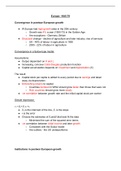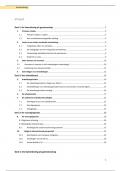Europe: 1945-79
Convergence in postwar European growth
● W.Europe had high growth rates in the 20th century
○ Growth was 4% a year (1950-73) in the Golden Age
○ Are exceptions - Germany, Britain
● Structural change - decline of agriculture and later industry, rise of services
○ UK - 49% of labour in agriculture in 1950
○ 2005 - 22% of labour in agriculture
Convergence in a Solow-type model
Assumptions
● Output dependent on K and L
● Increasing, concave Cobb-Douglas production function
● Capital accumulation depends on investment and depreciation (𝛿)
The result
● Capital stock per capita is added to every period due to savings and taken
away via depreciation
● Diminishing returns to capital
○ Countries bombed in WW2 should grow faster than those that were not
○ Rich countries should grow more slowly
● -ve correlation between growth rate and the initial capital stock per worker
Simple regression
y i=β 0 + β 1 x i +ε i
● β 0 is the intercept of the line, β 1 is the slope
● ε iis the error
● Choose the estimates of β 0and β 1that best fit the data
○ Minimised the sum of the squared error terms
● -ve correlation between initial income and later growth
○ Consistent with the Solow model
○ Are outliers - the UK underperforms
Institutions in postwar European growth
, Low wage, high investment bargain
Eichengreen (1996) - EU countries that invested more grew faster. Investment needs
a bargain between labour and capital
● Wage restraint and high investment
● Consumer prices and wages may rise by the same amount, even if
productivity rises
● Means profits were reinvested, not spent as wages/dividends
● 1950s GER, NOR, BEL - wage restraint combined with investment-friendly
policies
○ Called productivity agreements in Belgium
● UK - intense wage pressure, lower investment ratios and growth rates
Securing commitment
Eichengreen (1999) - commitment can be secured in 3 ways
● Monitoring compliance
○ Workers monitoring manager’s investment decisions
○ Unions sharing wage and investment info
○ Unions represented on committees
● Bonds that would be lost
○ Bonds - if a firm / worker isn’t up to standard they are given a hostage
that can be taken away / they give a hostage
○ Firms - subsidies, below market price materials, tax penalties
○ Workers - welfare state, pension schemes
● Coordinating mechanisms
○ Bargaining via unions, employer’s associations or govt intervention
The national economy
Eichengreen (1996) - integration within Europe and beyond
● Within Europe, firms needed to invest without thinking about the size of the
domestic market
○ Made possible by multilateral institutions - European Payments Union
○ Opened up trade in the 1950s Western world
○ Increased bilateral, rather than multilateral trade
● Outside Europe, GATT prevented conflict between trade liberalisation
regionally and globally
○ Fixed exchange rate - moderate inflation made macro policy more
effective
The end of the post-war settlement
Eichengreen (1996) - the end of catch-up growth is to blame
● Causes declining return on investment
Convergence in postwar European growth
● W.Europe had high growth rates in the 20th century
○ Growth was 4% a year (1950-73) in the Golden Age
○ Are exceptions - Germany, Britain
● Structural change - decline of agriculture and later industry, rise of services
○ UK - 49% of labour in agriculture in 1950
○ 2005 - 22% of labour in agriculture
Convergence in a Solow-type model
Assumptions
● Output dependent on K and L
● Increasing, concave Cobb-Douglas production function
● Capital accumulation depends on investment and depreciation (𝛿)
The result
● Capital stock per capita is added to every period due to savings and taken
away via depreciation
● Diminishing returns to capital
○ Countries bombed in WW2 should grow faster than those that were not
○ Rich countries should grow more slowly
● -ve correlation between growth rate and the initial capital stock per worker
Simple regression
y i=β 0 + β 1 x i +ε i
● β 0 is the intercept of the line, β 1 is the slope
● ε iis the error
● Choose the estimates of β 0and β 1that best fit the data
○ Minimised the sum of the squared error terms
● -ve correlation between initial income and later growth
○ Consistent with the Solow model
○ Are outliers - the UK underperforms
Institutions in postwar European growth
, Low wage, high investment bargain
Eichengreen (1996) - EU countries that invested more grew faster. Investment needs
a bargain between labour and capital
● Wage restraint and high investment
● Consumer prices and wages may rise by the same amount, even if
productivity rises
● Means profits were reinvested, not spent as wages/dividends
● 1950s GER, NOR, BEL - wage restraint combined with investment-friendly
policies
○ Called productivity agreements in Belgium
● UK - intense wage pressure, lower investment ratios and growth rates
Securing commitment
Eichengreen (1999) - commitment can be secured in 3 ways
● Monitoring compliance
○ Workers monitoring manager’s investment decisions
○ Unions sharing wage and investment info
○ Unions represented on committees
● Bonds that would be lost
○ Bonds - if a firm / worker isn’t up to standard they are given a hostage
that can be taken away / they give a hostage
○ Firms - subsidies, below market price materials, tax penalties
○ Workers - welfare state, pension schemes
● Coordinating mechanisms
○ Bargaining via unions, employer’s associations or govt intervention
The national economy
Eichengreen (1996) - integration within Europe and beyond
● Within Europe, firms needed to invest without thinking about the size of the
domestic market
○ Made possible by multilateral institutions - European Payments Union
○ Opened up trade in the 1950s Western world
○ Increased bilateral, rather than multilateral trade
● Outside Europe, GATT prevented conflict between trade liberalisation
regionally and globally
○ Fixed exchange rate - moderate inflation made macro policy more
effective
The end of the post-war settlement
Eichengreen (1996) - the end of catch-up growth is to blame
● Causes declining return on investment











